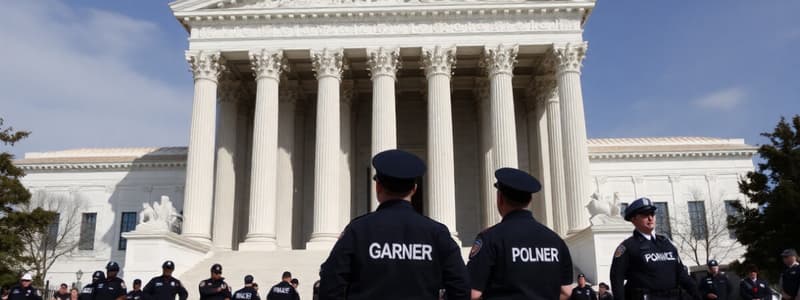Podcast
Questions and Answers
What was the primary legal issue in Tennessee v. Garner?
What was the primary legal issue in Tennessee v. Garner?
- Whether the Fourth Amendment protects against unreasonable seizures (correct)
- Whether an officer can shoot at a suspect escaping a robbery
- Whether officers should be trained on using deadly force
- Whether officers can shoot fleeing suspects without cause
Which major consideration did the Supreme Court address in its ruling?
Which major consideration did the Supreme Court address in its ruling?
- The number of incidents involving police shootings
- The requirement of probable cause before using deadly force (correct)
- The immediate financial impact on law enforcement budgets
- The necessity of apprehending suspects at all costs
What precedent did Tennessee v. Garner establish regarding police use of force?
What precedent did Tennessee v. Garner establish regarding police use of force?
- Officers must always apprehend suspects without hesitation
- Use of deadly force is narrowly defined and based on immediate threats (correct)
- Deadly force is permissible for all felony suspects
- Deadly force must align with community policing strategies
What outcome did the Supreme Court ultimately reach in this case?
What outcome did the Supreme Court ultimately reach in this case?
According to the Supreme Court's ruling, which of the following is NOT an adequate justification for using deadly force?
According to the Supreme Court's ruling, which of the following is NOT an adequate justification for using deadly force?
In the context of the ruling, the Court emphasized a balance between which two concepts?
In the context of the ruling, the Court emphasized a balance between which two concepts?
What did the case reveal about the obligations of law enforcement officers?
What did the case reveal about the obligations of law enforcement officers?
Which aspect of the case addressed the concept of proportionality?
Which aspect of the case addressed the concept of proportionality?
What was the eventual fate of Edward Garner in the context of this case?
What was the eventual fate of Edward Garner in the context of this case?
How did the Court’s decision impact future cases regarding police use of force?
How did the Court’s decision impact future cases regarding police use of force?
What is the primary consequence of chronic Hepatitis B infection?
What is the primary consequence of chronic Hepatitis B infection?
Which virus is primarily responsible for attacking the immune system?
Which virus is primarily responsible for attacking the immune system?
What is a key component of an exposure control plan in healthcare settings?
What is a key component of an exposure control plan in healthcare settings?
Which of the following is a treatment option available for Hepatitis C?
Which of the following is a treatment option available for Hepatitis C?
How can proper use of personal protective equipment (PPE) help healthcare workers?
How can proper use of personal protective equipment (PPE) help healthcare workers?
What is the primary purpose of eye protection such as face shields or safety glasses?
What is the primary purpose of eye protection such as face shields or safety glasses?
Which of the following procedures is NOT recommended for handling sharps?
Which of the following procedures is NOT recommended for handling sharps?
Why is it crucial to initiate post-exposure prophylaxis (PEP) promptly?
Why is it crucial to initiate post-exposure prophylaxis (PEP) promptly?
What is essential for comprehensive employee training regarding bloodborne pathogens?
What is essential for comprehensive employee training regarding bloodborne pathogens?
Which statement about PPE is accurate?
Which statement about PPE is accurate?
Flashcards
Tennessee v. Garner
Tennessee v. Garner
A legal case that set a critical precedent for when police can use deadly force to stop a fleeing suspect.
Fourth Amendment
Fourth Amendment
The right to be free from unreasonable searches and seizures, as guaranteed by the Fourth Amendment of the US Constitution.
Probable Cause
Probable Cause
When an officer believes, with good reason, that a suspect poses a serious threat of death or injury to themselves or others, justifying the use of deadly force.
Apprehension
Apprehension
Signup and view all the flashcards
Fleeing
Fleeing
Signup and view all the flashcards
Proportionality
Proportionality
Signup and view all the flashcards
Vacate and Remand
Vacate and Remand
Signup and view all the flashcards
Precedent
Precedent
Signup and view all the flashcards
Further Proceedings
Further Proceedings
Signup and view all the flashcards
Balance
Balance
Signup and view all the flashcards
Bloodborne pathogens
Bloodborne pathogens
Signup and view all the flashcards
Hepatitis C Virus (HCV)
Hepatitis C Virus (HCV)
Signup and view all the flashcards
Exposure Control Plan
Exposure Control Plan
Signup and view all the flashcards
Personal Protective Equipment (PPE)
Personal Protective Equipment (PPE)
Signup and view all the flashcards
Post-Exposure Prophylaxis (PEP)
Post-Exposure Prophylaxis (PEP)
Signup and view all the flashcards
Eye Protection in Healthcare
Eye Protection in Healthcare
Signup and view all the flashcards
Sharps Containers
Sharps Containers
Signup and view all the flashcards
Bloodborne Pathogen Training
Bloodborne Pathogen Training
Signup and view all the flashcards
Bloodborne Pathogen Standard (BBPS)
Bloodborne Pathogen Standard (BBPS)
Signup and view all the flashcards
Study Notes
Background of the Case
- Tennessee v. Garner was a 1985 Supreme Court case regarding the use of deadly force by law enforcement officers during arrests.
- The case centered on a situation where a fleeing suspect was shot and killed by an officer.
Facts of the Case
- Edward Garner fled after allegedly attempting a burglary.
- A police officer shot and killed Garner while he was running.
- The officer claimed Garner presented a significant threat, justifying the use of deadly force.
- The state's highest court supported the officer’s actions.
Legal Issues
- The core legal issue was whether using deadly force to stop a fleeing felon violated the Fourth Amendment's protection against unreasonable seizures.
Supreme Court's Ruling
- The Supreme Court ruled that deadly force is permissible only when the officer has probable cause that the suspect poses an immediate threat of death or serious injury to the officer or others.
- The Court emphasized that flight alone doesn't justify deadly force.
- The Supreme Court overturned the lower court's decision and sent the case back for further proceedings.
Significance of the Decision
- Tennessee v. Garner created a key precedent for deciding the legitimacy of police use of deadly force.
- The decision significantly altered the legal framework surrounding police force.
- Deadly force use during pursuits was restricted by this ruling.
- The case highlighted the need for law enforcement officers to demonstrate a legitimate justification for using deadly force, focusing on the imminent threat posed by the suspect.
- The ruling promoted a balance between public safety and individual rights.
Key Elements of the Decision
- The Court deemed the use of deadly force in this case unreasonable.
- The Court recognized the balance needed between public protection and individual liberties.
- The ruling distinguished between apprehending a suspect who poses an imminent threat and one who is simply fleeing.
- The importance of proportional force in law enforcement was stressed.
- The Court provided guidelines for evaluating the appropriateness of deadly force in similar situations.
Impact on Law Enforcement Practices
- The Garner decision significantly modified law enforcement training and policies throughout the United States.
- Police departments updated their rules on deadly force, emphasizing caution, reasonableness, and proportionality.
- Law enforcement officers became more aware of legal restrictions on using deadly force.
- Post-Garner training and policies prioritize assessing the threat, evaluating the danger of serious injury or death, and exploring non-lethal alternatives for force.
Bloodborne Pathogens
- Bloodborne pathogens are microorganisms that can cause disease when transmitted through blood or other bodily fluids.
- They are a significant occupational hazard for healthcare workers and others who may have contact with blood or potentially infectious materials.
- Common bloodborne pathogens include Hepatitis B virus (HBV), Hepatitis C virus (HCV), and Human Immunodeficiency Virus (HIV).
- Exposure can lead to serious health consequences.
Hepatitis B Virus (HBV)
- HBV is a DNA virus that infects the liver.
- Spread through contact with infected blood or bodily fluids.
- Symptoms can range from asymptomatic to acute or chronic liver disease.
- Vaccination is highly effective.
- Chronic HBV can lead to cirrhosis and liver cancer.
Hepatitis C Virus (HCV)
- HCV is an RNA virus affecting the liver.
- Primarily spread through contact with infected blood.
- Often asymptomatic initially, potentially leading to chronic liver damage.
- Treatable with antiviral medications.
- Treatment can cure infection and prevent long-term liver disease.
Human Immunodeficiency Virus (HIV)
- HIV is a retrovirus attacking the immune system.
- Spread through contact with infected blood or bodily fluids.
- Initial symptoms can be mild or absent.
- Progresses to Acquired Immunodeficiency Syndrome (AIDS) if untreated.
- Antiretroviral therapy (ART) slows disease progression.
Exposure Control Plan
- A comprehensive exposure control plan is essential in workplaces with potential bloodborne pathogen exposure.
- Details measures to minimize exposure.
- Key components:
- Engineering controls (e.g., sharps containers, PPE, safe handling procedures).
- Work practice controls (e.g., handwashing, decontamination).
- Employee training on bloodborne pathogen standards and safe work practices.
- Post-exposure prophylaxis (PEP) information and guidance.
Personal Protective Equipment (PPE)
- Proper PPE dramatically reduces exposure risk.
- Gloves protect hands from blood and bodily fluids.
- Eye protection (e.g., face shields, safety glasses) protects eyes.
- Other PPE (e.g., gowns, masks) needed based on exposure level.
- PPE must be appropriate, properly fitted, and used correctly.
Sharps Safety
- Sharps injuries are a significant bloodborne pathogen exposure source.
- Strict adherence to sharps safety procedures is crucial.
- Use of sharps containers with proper closure systems is mandatory.
- Never recap needles, dispose of used sharps in designated containers.
Post-Exposure Prophylaxis (PEP)
- PEP is a combination of medications given after potential bloodborne pathogen exposure.
- PEP should be initiated promptly.
- PEP regimens vary based on the pathogen.
Training and Education
- Comprehensive employee training is essential.
- Training covers identifying potentially infectious materials and avoiding exposure.
- Continuous learning on bloodborne pathogens is needed.
- Regular reviews of the Bloodborne Pathogen Standard by healthcare facilities are necessary.
Studying That Suits You
Use AI to generate personalized quizzes and flashcards to suit your learning preferences.




